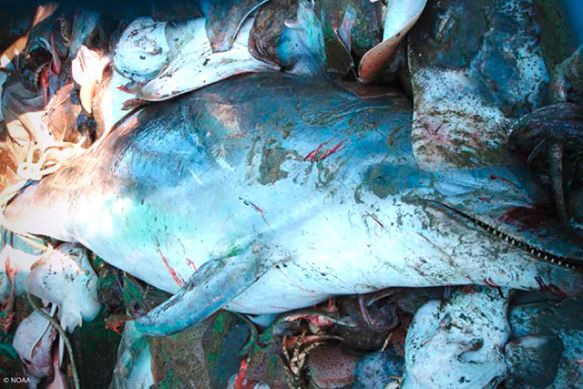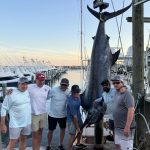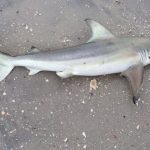A new report from Oceana shows the staggering amount of seafood U.S. fisheries waste.
The images are heartwrenching: a sweet young sea lion found in Hawaii bearing a gash in its neck after being tangled in fishing line. A graceful sea turtle snarled in a net at risk of drowning. A lifeless dolphin caught in a gill net off California’s coast.
From sharks, salmon, rockfish, and crabs to lesser-known species such as tilefish, porgies, and lookdowns, bycatch—the unintended capture of non-targeted fish or marine life—happens every day in U.S. waters.
In a report out today, Oceana analyzed federal fisheries data that shows American fishermen are discarding up to 22 percent of their catch and identified nine fisheries it says are the worst offenders. Oceana says the government isn’t doing enough to track what’s being tossed overboard by fishermen, and officials aren’t enforcing existing policies and regulations. The report also says officials aren’t taking steps to minimize what’s accidently caught in the first place by implementing adequate monitoring or requiring that changes be made to fishing gear either.
The worst American fishery on Oceana’s list? The Southeast Snapper-Grouper Longline Fishery, which discarded 66 percent of its total catch in 2010, including more than 400,000 sharks. That was closely followed by the California Set Gillnet Fishery, which tossed 65 percent of its catch in 2007, 2010, and 2011, including more than 12,000 sharks and rays, and 470 seals and sea lions.
The Southeast Shrimp Trawl Fishery in the Gulf of Mexico and South Atlantic had some of the highest discard rates, tossing an estimated 229 million pounds of fish and killing up to 50,000 sea turtles annually. All told, Oceana estimates the fishery discards a whopping 64 percent of its catch.
Other fisheries called out in the report include Gulf of Alaska Flatfish Trawl Fishery, gill net fisheries in California, New England, and the Mid-Atlantic, and the Atlantic Highly Migratory Species Longline Fishery, where fish such as bluefin tuna, yellowfin tuna, swordfish, blue sharks, blue marlin, and other billfish species are caught.
Oceana says some fishing methods are more harmful than others. U.S. bycatch is the highest among trawl, longline, and gill net fisheries. Trawl fisheries, used in shrimp harvesting, drag large nets across the seafloor, scooping up nearly everything in their path. Longline fisheries, like those used for swordfish, use lines set with baited hooks that can extend for 50 miles. Gill nets, which can drift or be anchored, are designed so fish get stuck around their gills when trying to swim by, and they catch more than just one targeted species.
Oceana campaign director Dominique Cano-Stocco says there are better alternatives, including swordfish caught by harpoon or spot prawns caught by trap.
The sheer numbers are numbing. According to the report, bycatch in the U.S. could add up to 2 billion pounds every year, a figure that’s equivalent to the entire annual catch of many other fishing nations around the world, says Oceana.
“We’re not saying fishermen are bad,” says Cano-Stocco. “We’re not looking for new regulations but rather enforcement of current regulations. There is tremendous waste. The nine fisheries combined throw away half as much as we keep. That’s equivalent to a half-billion seafood meals. That’s staggering, right?”
In 2011, the National Oceanic and Atmospheric Administration published its first U.S. National Bycatch Report, using data from 2005—a six-year lag. While the report has been updated using mostly 2010 numbers, a comprehensive update of bycatch data isn’t expected until 2017. Cano-Stocco says that is too long to wait. NOAA did not grant our request for an interview.
Many scientists and environmentalists agree that bycatch is one of the most immediate and daunting threats to a variety of marine species. Unfortunately, there is no simple remedy for the problem.
“Anywhere you put fishing gear in the water, you get bycatch. You toss out a line for tuna, and you might hook a shark. You put a net out for fish or lobster, and you catch dolphin or turtle,” says Tim Werner, a senior scientist with the New England Aquarium and director of the Consortium for Wildlife Bycatch Reduction, which recently won a Katerva Award for its work on the issue.
Werner, whose group maintains a bycatch reduction techniques database, says solutions need to be looked at on a fishery-by-fishery basis. For example, acoustic deterrents like pingers worked well in eliminating bycatch of harbor porpoise, while “whale safe” circle hooks bend, allowing a larger marine mammal to escape. Fishermen sharing “hot spot” information can help one another avoid areas swarming with fish that are not being targeted for harvest.
“Many of the most sustainable and effective solutions are ideas that have originated with fishermen. They have the incentive to change,” says Werner. “Unfortunately, the threat of bycatch far outpaces the number of solutions we have available in our toolkit to solve this problem.”
Werner says he suspects most consumers would be alarmed and concerned by bycatch if they understood that the tuna steak on their plate, the flounder in butter sauce, or the lobster roll they’re eating has an invisible mortality associated with it.
“Imagine if you’re a meat eater and you ate a hamburger, saying, ‘It’s a real bummer that all kinds of wolves and bears and a host of other species had to die in order for me to eat that,’ ” he says.
The rules on whether or not fishermen can bring some of that bycatch to shore for seafood lovers is complicated and can depend on the species and where it’s caught. A bluefin tuna caught as bycatch off California, for example, can be brought back to shore, while nearly 25 percent of our nation’s Atlantic bluefin quota—nearly 240 metric tons ends up discarded.
In some areas, such as Houston, bycatch is being embraced thanks, in part, to fishmonger PJ Stoops, who helped introduce it to adventurous chefs; while groups like Chefs Collaborative have been hosting a series of “Trash Fish” dinners around the country to help raise awareness of bycatch and to introduce eaters to fish beyond the typical shrimp, salmon, and tuna.
But bringing all bycatch to shore and trying to sell it comes with its own set of concerns, including the risk of introducing fishing pressure to species that don’t have regulatory protections in place—a scenario that neither scientists nor environmentalists recommend.
The Oceana report offers recommendations on how the U.S. can do better when it comes to bycatch.
“Everything that is capture, even if discarded, should be counted and documented with accuracy and precision,” says the report.
Other recommendations include establishing bycatch limits and shutting down fisheries that exceed those limits, improving bycatch reporting procedures across Fishery Management Plans, and putting incentives in place that entice fishermen to use better gear.
“The goal here is to improve the health of our ocean, and you don’t have to stop fishing to do it,” says Cano-Stocco. “But it’s important to show the impact of bycatch on fisheries and ask for improvement.”
Originally posted on takepart.com on March 20, 2014 – please click here to view original article.






